206年翻译硕士传统文化常识:成语典
- 格式:docx
- 大小:22.97 KB
- 文档页数:3
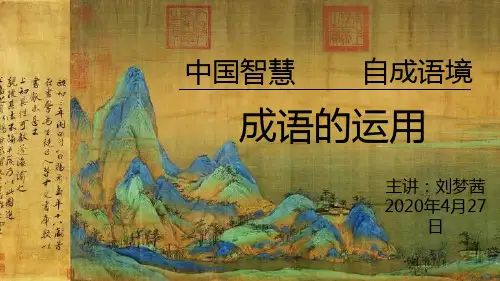

2023年成语解释及出处2023年成语解释及出处1解释:平安无事,没有遭受损害或发生意外。
恙,疾病,借指灾祸。
出处:公元前266年,赵国国君赵惠文王去世,他的儿子太子丹接位为赵孝成王。
由于孝成王还年轻,国家大事由他的母亲赵威后负责处理。
赵威后是一个比较贤明而有见识的中年妇女。
她刚刚主持国事的时候,秦国加剧了对赵国的进攻。
赵国危急,向齐国求救,齐国要赵威后把她的小儿子长安君送到齐国作人质,然后再出兵。
赵威后舍不得小儿子离开,但是听了大臣触龙的意见,还是把长安君送到齐国。
齐国出兵帮助赵国打退了秦军。
有一次,齐王派使者带着信到赵国问候赵威后。
威后还没有拆信就问使者。
“齐国的收成不坏吧?老百姓平安吗?齐王身体健康吗?”齐国使者听了心里很不高兴,说:“我受齐王派遣来问候您,现在你不先问齐王,却先问收成和百姓,难道可以把低贱的放在前面,把尊贵的放在后面吗?”威后微微一笑,说:“不是的。
如果没有收成,怎么会有百姓?如果没有百姓,怎么会有君主?难道问候时可以舍弃根本而只问枝节吗?”齐国使者听了,一时说不出话来。
这则“无恙”的典故,后来演化出成语,“安然无恙”。
2023年成语解释及出处2花好月圆huā hǎo yuè yuán[释义]花儿是美的;月亮是圆的。
比喻美好团聚。
多用做新婚贺词。
[语出]宋·晁次膺(端礼)《行香子·别恨》词:“莫思身外;且逗尊前;愿花长好;人长健;月常圆。
”[正音]好;不能读作“hào”。
[辨形]圆;不能写作“园”。
[近义]鹊笑鸠舞[反义]花残月缺[用法]比喻美好、圆满的生活。
常用作祝人幸福美满的新婚颂辞。
一般作谓语、定语。
[结构]联合式。
[例句]①祝你们~;白头偕老。
②我们结婚的东西都已准备好;就等着~的那一天了。
[英译]perfect conjugal bliss2023年成语解释及出处3明修栈道,暗渡陈仓míng xiū zhàn dào,àn dù chén cāng成语解释:比喻用一种假象迷惑对方,实际上却另有打算。
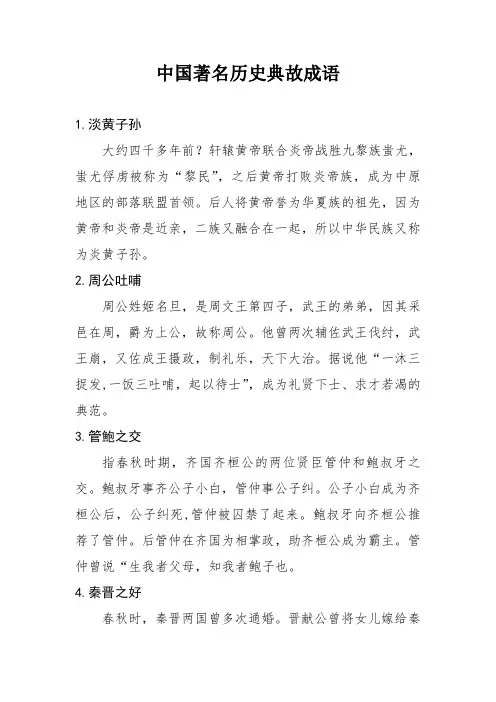
中国著名历史典故成语1.淡黄子孙大约四千多年前?轩辕黄帝联合炎帝战胜九黎族蚩尤,蚩尤俘虏被称为“黎民”,之后黄帝打败炎帝族,成为中原地区的部落联盟首领。
后人将黄帝誉为华夏族的祖先,因为黄帝和炎帝是近亲,二族又融合在一起,所以中华民族又称为炎黄子孙。
2.周公吐哺周公姓姬名旦,是周文王第四子,武王的弟弟,因其采邑在周,爵为上公,故称周公。
他曾两次辅佐武王伐纣,武王崩,又佐成王摄政,制礼乐,天下大治。
据说他“一沐三捉发,一饭三吐哺,起以待士”,成为礼贤下士、求才若渴的典范。
3.管鮑之交指春秋时期,齐国齐桓公的两位贤臣管仲和鲍叔牙之交。
鲍叔牙事齐公子小白,管仲事公子纠。
公子小白成为齐桓公后,公子纠死,管仲被囚禁了起来。
鲍叔牙向齐桓公推荐了管仲。
后管仲在齐国为相掌政,助齐桓公成为霸主。
管仲曾说“生我者父母,知我者鲍子也。
4.秦晋之好春秋时,秦晋两国曾多次通婚。
晋献公曾将女儿嫁给秦穆公。
后献公妃子骊姬为乱,迫害献公之子申生、重耳。
重耳流亡在外十九年,流亡到秦国时,秦穆公将自己的女儿文嬴并同宗四女嫁给了重耳。
公元前 636 年,穆公帮助晋国流亡公子重耳回国做了国君,成就了“秦晋之好”。
5.楚王问鼎《左传》记载,春秋时期,楚庄王曾率兵北伐至洛水,向周王朝炫耀武力,周定王派王孙满前去犒劳楚军,而楚庄王向王孙满询问周朝传国之宝九鼎的大小轻重,王孙满回答说“在德不在鼎”。
鼎是古代国家权力的象征,楚庄公问鼎之轻重,有取代周室之意,“问鼎中原”源于此。
6.春秋五霸、战国七雄春秋五霸指春秋彔期五次诸侯会盟的盟主齐桓公、晋文公、宋襄公、秦穆公、楚庄公,一说指齐桓公,晋襄公,楚庄王,吴王阖闾,越王勾践。
战国七雄指战国时期的七个最强的诸侯国齐、楚、燕、韩、赵、魏、秦。
7.合纵连横自秦孝公起,强大的秦国便有了统一天下的雄心,在纵横家苏秦的游说主张下,齐、楚、燕、韩、赵、魏六国结成联盟,“合纵”抗秦,秦谋士张仪则提出远交近攻的策略,用“连横”瓦解联盟,为秦国统一中国奠定了基础。
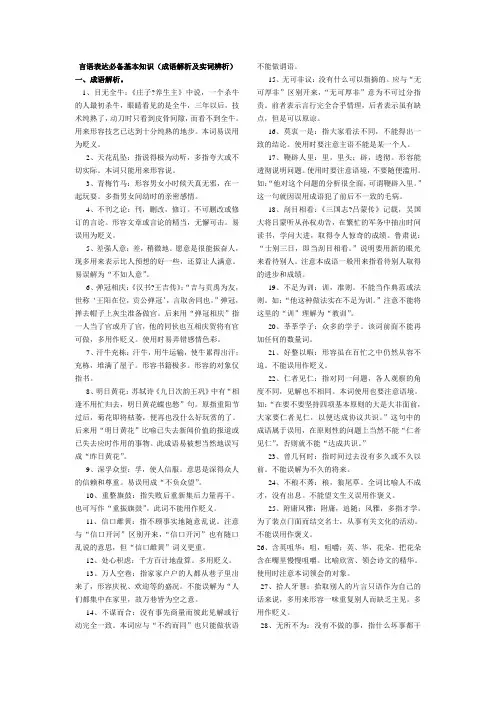
言语表达必备基本知识(成语解析及实词辨析)一、成语解析。
1、目无全牛:《庄子?养生主》中说,一个杀牛的人最初杀牛,眼睛看见的是全牛,三年以后,技术纯熟了,动刀时只看到皮骨间隙,而看不到全牛。
用来形容技艺已达到十分纯熟的地步。
本词易误用为贬义。
2、天花乱坠:指说得极为动听,多指夸大或不切实际。
本词只能用来形容说。
3、青梅竹马:形容男女小时候天真无邪,在一起玩耍。
多指男女间幼时的亲密感情。
4、不刊之论:刊,删改,修订。
不可删改或修订的言论。
形容文章或言论的精当,无懈可击。
易误用为贬义。
5、差强人意:差,稍微地。
愿意是很能振奋人,现多用来表示比人预想的好一些,还算让人满意。
易误解为“不如人意”。
6、弹冠相庆:《汉书?王吉传》:“吉与贡禹为友,世称‘王阳在位,贡公弹冠’,言取舍同也。
”弹冠,掸去帽子上灰尘准备做官。
后来用“弹冠相庆”指一人当了官或升了官,他的同伙也互相庆贺将有官可做,多用作贬义。
使用时易弄错感情色彩。
7、汗牛充栋:汗牛,用牛运输,使牛累得出汗;充栋,堆满了屋子。
形容书籍极多。
形容的对象仅指书。
8、明日黄花:苏轼诗《九日次韵王巩》中有“相逢不用忙归去,明日黄花蝶也愁”句。
原指重阳节过后,菊花即将枯萎,便再也没什么好玩赏的了。
后来用“明日黄花”比喻已失去新闻价值的报道或已失去应时作用的事物。
此成语易被想当然地误写成“昨日黄花”。
9、深孚众望:孚,使人信服。
意思是深得众人的信赖和尊重。
易误用成“不负众望”。
10、重整旗鼓:指失败后重新集后力量再干。
也可写作“重振旗鼓”。
此词不能用作贬义。
11、信口雌黄:指不顾事实地随意乱说。
注意与“信口开河”区别开来,“信口开河”也有随口乱说的意思,但“信口雌黄”词义更重。
12、处心积虑:千方百计地盘算。
多用贬义。
13、万人空巷:指家家户户的人都从巷子里出来了,形容庆祝、欢迎等的盛况。
不能误解为“人们都集中在家里,故万巷皆为空之意。
14、不谋而合:没有事先商量而彼此见解或行动完全一致。
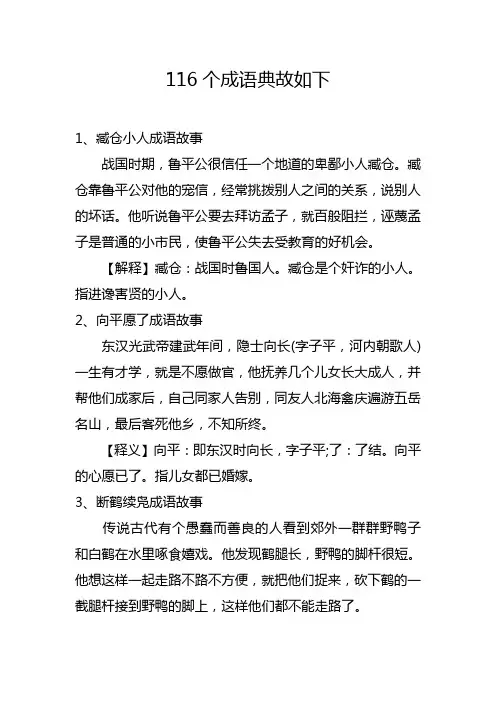
116个成语典故如下1、臧仓小人成语故事战国时期,鲁平公很信任一个地道的卑鄙小人臧仓。
臧仓靠鲁平公对他的宠信,经常挑拨别人之间的关系,说别人的坏话。
他听说鲁平公要去拜访孟子,就百般阻拦,诬蔑孟子是普通的小市民,使鲁平公失去受教育的好机会。
【解释】臧仓:战国时鲁国人。
臧仓是个奸诈的小人。
指进谗害贤的小人。
2、向平愿了成语故事东汉光武帝建武年间,隐士向长(字子平,河内朝歌人)一生有才学,就是不愿做官,他抚养几个儿女长大成人,并帮他们成家后,自己同家人告别,同友人北海禽庆遍游五岳名山,最后客死他乡,不知所终。
【释义】向平:即东汉时向长,字子平;了:了结。
向平的心愿已了。
指儿女都已婚嫁。
3、断鹤续凫成语故事传说古代有个愚蠢而善良的人看到郊外一群群野鸭子和白鹤在水里啄食嬉戏。
他发现鹤腿长,野鸭的脚杆很短。
他想这样一起走路不路不方便,就把他们捉来,砍下鹤的一截腿杆接到野鸭的脚上,这样他们都不能走路了。
【解释】断:截断;续:接;凫:野鸭。
截断鹤的长腿去接续野鸭的短腿。
比喻行事违反自然规律。
4、霜露之疾成语故事西汉时期,丞相公孙弘出身牧人家庭,40岁才去读书,很快就被汉武帝拜为丞相,他办事认真,得罪了一些权贵,加上他出身低微,经常被人看不起。
他推说自己有病要辞职,汉武帝看出他只不过是霜露之疾罢了,挽留他继续干下去。
【解释】指因风寒而引起的疾病,指感冒。
5、淮南鸡犬成语故事汉高祖刘邦的孙子淮南王刘安十分信奉道教,为了长生不老,他找到八公仙翁,按照八公仙翁的话炼制仙丹。
丹药炼成后,刘安吃下觉得自己轻飘飘的升天而去。
庭院里的鸡狗抢着吃剩下的丹药也纷纷飞上天成了仙。
【解释】淮南王的鸡和狗。
比喻投靠别人而得势的人。
6、大笔如椽成语故事东晋文人王珣从小才思敏捷,胆识过人,20岁时担任大司马桓温的主簿。
他经常是口若悬河,下笔成文。
一天晚上王珣做了一个梦,梦中有人送给他一支像椽子那样大的笔,预感有大手笔的事情要做。
第二天果然被叫去为晋孝武帝写祭文。
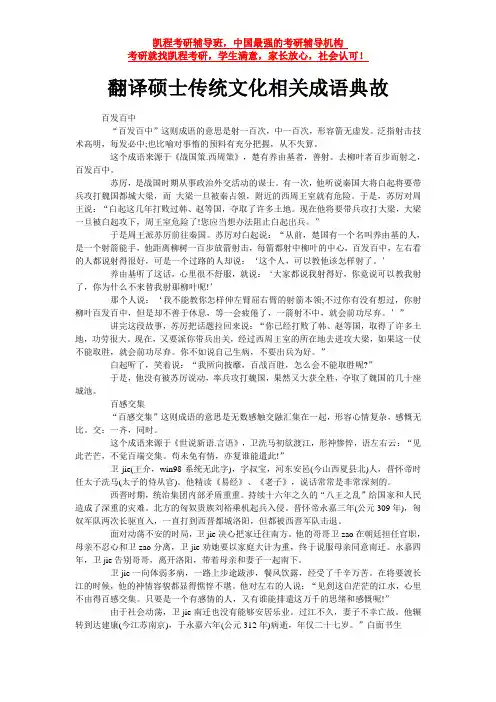
翻译硕士传统文化相关成语典故百发百中“百发百中”这则成语的意思是射一百次,中一百次,形容箭无虚发。
泛指射击技术高明,每发必中;也比喻对事惰的预料有充分把握,从不失算。
这个成语来源于《战国策.西周策》,楚有养由基者,善射。
去柳叶者百步而射之,百发百中。
苏厉,是战国时期从事政治外交活动的谋士。
有一次,他听说秦国大将白起将要带兵攻打魏国都城大梁,而大梁一旦被秦占领,附近的西周王室就有危险。
于是,苏厉对周王说:“白起这几年打败过韩、赵等国,夺取了许多土地。
现在他将要带兵攻打大梁,大梁一旦被白起攻下,周王室危险了!您应当想办法阻止白起出兵。
”于是周王派苏厉前往秦国。
苏厉对白起说:“从前,楚国有一个名叫养由基的人,是一个射箭能手,他距离柳树一百步放箭射击,每箭都射中柳叶的中心,百发百中,左右看的人都说射得很好,可是一个过路的人却说:‘这个人,可以教他该怎样射了。
’养由基听了这话,心里很不舒服,就说:‘大家都说我射得好,你竟说可以教我射了,你为什么不来替我射那柳叶呢!’那个人说:‘我不能教你怎样伸左臂屈右臂的射箭本领;不过你有没有想过,你射柳叶百发百中,但是却不善于休息,等一会疲倦了,一箭射不中,就会前功尽弃。
’”讲完这段故事,苏厉把话题拉回来说:“你已经打败了韩、赵等国,取得了许多土地,功劳很大。
现在,又要派你带兵出关,经过西周王室的所在地去进攻大梁,如果这一仗不能取胜,就会前功尽弃。
你不如说自己生病,不要出兵为好。
”白起听了,笑着说:“我所向披靡,百战百胜,怎么会不能取胜呢?”于是,他没有被苏厉说动,率兵攻打魏国,果然又大获全胜,夺取了魏国的几十座城池。
百感交集“百感交集”这则成语的意思是无数感触交融汇集在一起,形容心情复杂,感慨无比。
交:一齐,同时。
这个成语来源于《世说新语.言语》,卫洗马初欲渡江,形神惨悴,语左右云:“见此芒芒,不觉百端交集。
苟未免有情,亦复谁能遣此!”卫jie(王介,win98系统无此字),字叔宝,河东安邑(今山西夏县北)人,晋怀帝时任太子洗马(太子的侍从官)。
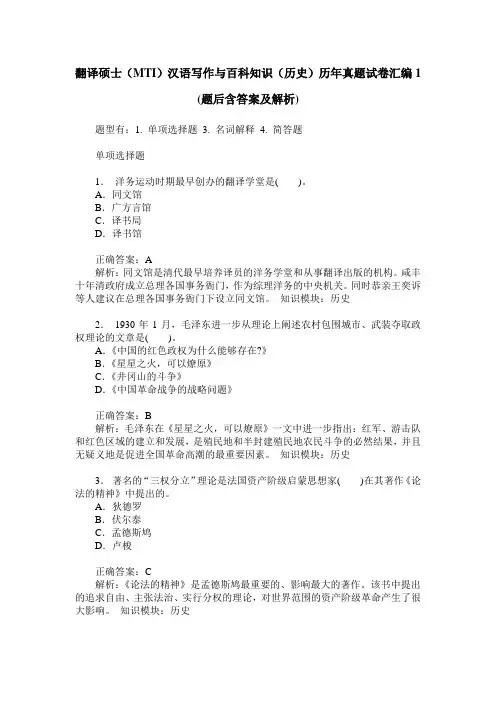
翻译硕士(MTI)汉语写作与百科知识(历史)历年真题试卷汇编1(题后含答案及解析)题型有:1. 单项选择题 3. 名词解释 4. 简答题单项选择题1.洋务运动时期最早创办的翻译学堂是( )。
A.同文馆B.广方言馆C.译书局D.译书馆正确答案:A解析:同文馆是清代最早培养译员的洋务学堂和从事翻译出版的机构。
咸丰十年清政府成立总理各国事务衙门,作为综理洋务的中央机关。
同时恭亲王奕诉等人建议在总理各国事务衙门下设立同文馆。
知识模块:历史2.1930年1月,毛泽东进一步从理论上阐述农村包围城市、武装夺取政权理论的文章是( )。
A.《中国的红色政权为什么能够存在?》B.《星星之火,可以燎原》C.《井冈山的斗争》D.《中国革命战争的战略问题》正确答案:B解析:毛泽东在《星星之火,可以燎原》一文中进一步指出:红军、游击队和红色区域的建立和发展,是殖民地和半封建殖民地农民斗争的必然结果,并且无疑义地是促进全国革命高潮的最重要因素。
知识模块:历史3.著名的“三权分立”理论是法国资产阶级启蒙思想家( )在其著作《论法的精神》中提出的。
A.狄德罗B.伏尔泰C.孟德斯鸠D.卢梭正确答案:C解析:《论法的精神》是孟德斯鸠最重要的、影响最大的著作。
该书中提出的追求自由、主张法治、实行分权的理论,对世界范围的资产阶级革命产生了很大影响。
知识模块:历史4.“完璧归赵”“怒发冲冠”等成语出于蔺相如的故事,这个故事来自历史书( )。
A.《左传》B.《战国策》C.《史记》D.《汉书》正确答案:C解析:“完璧归赵”“怒发冲冠”出自西汉司马迁《史记.廉颇蔺相如列传》。
知识模块:历史5.古代中国,在不同的历史时期,曾多次和其他国家有过对外交流。
汉武帝派( )出使西域,是中国有史以来的第一次中外交流。
A.徐光启B.郑和C.张骞D.玄奘正确答案:C解析:徐光启和郑和是明朝人,玄奘是唐朝人,张骞出使西域开辟了著名的“丝绸之路”。
知识模块:历史6.中国古代医药学著作现存约8000多种,形成了完整的理论体系。
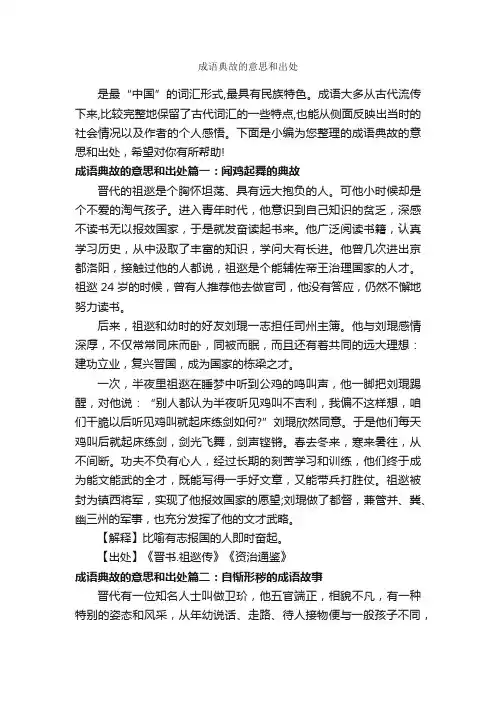
成语典故的意思和出处是最“中国”的词汇形式,最具有民族特色。
成语大多从古代流传下来,比较完整地保留了古代词汇的一些特点,也能从侧面反映出当时的社会情况以及作者的个人感悟。
下面是小编为您整理的成语典故的意思和出处,希望对你有所帮助!成语典故的意思和出处篇一:闻鸡起舞的典故晋代的祖逖是个胸怀坦荡、具有远大抱负的人。
可他小时候却是个不爱的淘气孩子。
进入青年时代,他意识到自己知识的贫乏,深感不读书无以报效国家,于是就发奋读起书来。
他广泛阅读书籍,认真学习历史,从中汲取了丰富的知识,学问大有长进。
他曾几次进出京都洛阳,接触过他的人都说,祖逖是个能辅佐帝王治理国家的人才。
祖逖24岁的时候,曾有人推荐他去做官司,他没有答应,仍然不懈地努力读书。
后来,祖逖和幼时的好友刘琨一志担任司州主簿。
他与刘琨感情深厚,不仅常常同床而卧,同被而眠,而且还有着共同的远大理想:建功立业,复兴晋国,成为国家的栋梁之才。
一次,半夜里祖逖在睡梦中听到公鸡的鸣叫声,他一脚把刘琨踢醒,对他说:“别人都认为半夜听见鸡叫不吉利,我偏不这样想,咱们干脆以后听见鸡叫就起床练剑如何?”刘琨欣然同意。
于是他们每天鸡叫后就起床练剑,剑光飞舞,剑声铿锵。
春去冬来,寒来暑往,从不间断。
功夫不负有心人,经过长期的刻苦学习和训练,他们终于成为能文能武的全才,既能写得一手好文章,又能带兵打胜仗。
祖逖被封为镇西将军,实现了他报效国家的愿望;刘琨做了都督,兼管并、冀、幽三州的军事,也充分发挥了他的文才武略。
【解释】比喻有志报国的人即时奋起。
【出处】《晋书.祖逖传》《资治通鉴》成语典故的意思和出处篇二:自惭形秽的成语故事晋代有一位知名人士叫做卫玠,他五官端正,相貌不凡,有一种特别的姿态和风采,从年幼说话、走路、待人接物便与一般孩子不同,人人见了都很喜爱。
有一天,母亲在给他梳头的时候说:“你是卫国第一美男子,随时都应该注意自己的仪态举止。
”卫玠惊愕地看着母亲,“我真的是卫国第一美男子?”母亲说:“你信的话,你出去问问其他人。
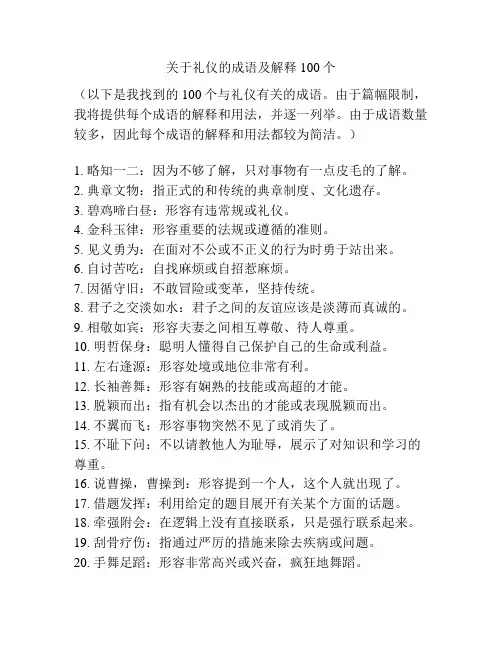
关于礼仪的成语及解释100个(以下是我找到的100个与礼仪有关的成语。
由于篇幅限制,我将提供每个成语的解释和用法,并逐一列举。
由于成语数量较多,因此每个成语的解释和用法都较为简洁。
)1. 略知一二:因为不够了解,只对事物有一点皮毛的了解。
2. 典章文物:指正式的和传统的典章制度、文化遗存。
3. 碧鸡啼白昼:形容有违常规或礼仪。
4. 金科玉律:形容重要的法规或遵循的准则。
5. 见义勇为:在面对不公或不正义的行为时勇于站出来。
6. 自讨苦吃:自找麻烦或自招惹麻烦。
7. 因循守旧:不敢冒险或变革,坚持传统。
8. 君子之交淡如水:君子之间的友谊应该是淡薄而真诚的。
9. 相敬如宾:形容夫妻之间相互尊敬、待人尊重。
10. 明哲保身:聪明人懂得自己保护自己的生命或利益。
11. 左右逢源:形容处境或地位非常有利。
12. 长袖善舞:形容有娴熟的技能或高超的才能。
13. 脱颖而出:指有机会以杰出的才能或表现脱颖而出。
14. 不翼而飞:形容事物突然不见了或消失了。
15. 不耻下问:不以请教他人为耻辱,展示了对知识和学习的尊重。
16. 说曹操,曹操到:形容提到一个人,这个人就出现了。
17. 借题发挥:利用给定的题目展开有关某个方面的话题。
18. 牵强附会:在逻辑上没有直接联系,只是强行联系起来。
19. 刮骨疗伤:指通过严厉的措施来除去疾病或问题。
20. 手舞足蹈:形容非常高兴或兴奋,疯狂地舞蹈。
21. 世外桃源:指处于世外的理想境地,远离现实烦扰的地方。
22. 礼尚往来:事情的处理要依照礼节,对方的礼貌要回报。
23. 善恶必分:善恶终究会分清楚,不会长期混淆不清。
24. 以邻为壑:指自己获益,使别人受害。
25. 少不更事:指幼稚、不懂事。
26. 疾如雷电:速度非常快。
27. 本末倒置:把主次事物弄颠倒。
28. 刻舟求剑:形容对事物认识停滞不前。
29. 触目惊心:形容景象令人极其震惊。
30. 忍辱负重:忍受屈辱,承担重负。

每日成语积累及解释全文共四篇示例,供读者参考第一篇示例:每日成语积累及解释成语是中国语言中独特的一部分,它蕴含着深邃的文化内涵和传统智慧。
熟练掌握成语不仅有助于提高语言表达能力,还可以让我们更好地理解中国传统文化。
每日积累成语并了解其含义是非常有必要的。
以下是一些常用的成语及其解释,希望能够对大家有所帮助。
1. 画龙点睛解释:指在画龙的眼睛上着墨,意指在创作或写作中,在关键的地方加以点染或点缀,使其更显突出。
例句:他善于画龙点睛,使整篇文章更加生动有趣。
2. 一箭双雕解释:比喻一举两得,一次行动同时达到两个目的。
例句:这次活动不仅促进了公司内部团结,还为公益事业做出了贡献,真可谓一箭双雕。
3. 亡羊补牢解释:比喻事情发生问题之后及时弥补错误,不至于造成更大的损失。
例句:他发现了公司财务出现问题,立即采取措施亡羊补牢,避免了更大的损失发生。
4. 杯弓蛇影解释:比喻人胆小,总是因为心虚而疑神疑鬼,有惊无险。
例句:她整天把花草当成毒蛇蛤蟆,真是杯弓蛇影,欠缺自信。
5. 隔岸观火解释:比喻置身事外,不协助有困难的人或称助人的人。
例句:面对朋友的危难,他却置若罔闻,简直是隔岸观火。
6. 一失足成千古恨解释:一次失误、疏忽或过失可能导致永久的懊悔和痛苦。
例句:他那天因为疏忽导致了一次重大错误,如今回想起来却一失足成千古恨。
7. 闭门造车解释:比喻孤立无准备的进行某种尝试或工作,结果往往难以成功。
例句:他们一直固执己见,闭门造车,结果项目失败了。
8. 蚁穴新穴,不可轻掉解释:比喻碰到困难时,不要轻易放弃,要不断寻找新的方法。
例句:遇到了困难,我们不能灰心丧气,要像蚂蚁一样勤奋努力,蚁穴新穴,不可轻掉。
9. 画蛇添足解释:比喻做某事过度,反而起到相反的结果,多此一举。
例句:他们组织了一场庞大的比赛,结果却因为画蛇添足,导致赛程混乱不堪。
10. 始于足下解释:意指从小事做起,从基础做起,才能够有所建树。
例句:要取得成功,必须脚踏实地,始于足下,不能急于求成。
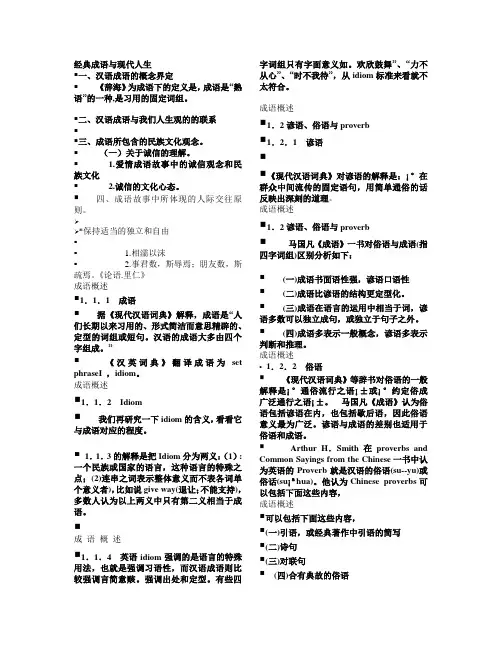
经典成语与现代人生▪一、汉语成语的概念界定▪《辞海》为成语下的定义是,成语是“熟语”的一种,是习用的固定词组。
▪二、汉语成语与我们人生观的的联系▪▪三、成语所包含的民族文化观念。
▪(一)关于诚信的理解。
▪ 1.爱情成语故事中的诚信观念和民族文化▪ 2.诚信的文化心态。
▪四、成语故事中所体现的人际交往原则。
➢➢*保持适当的独立和自由▪▪ 1.相濡以沫▪ 2.事君数,斯辱焉;朋友数,斯疏焉。
《论语.里仁》成语概述▪1.1.1 成语▪据《现代汉语词典》解释,成语是“人们长期以来习用的、形式简洁而意思精辟的、定型的词组或短句。
汉语的成语大多由四个字组成。
”▪《汉英词典》翻译成语为set phraseI ,idiom。
成语概述▪1.1.2 Idiom▪我们再研究一下idiom的含义,看看它与成语对应的程度。
▪1.1.3的解释是把Idiom分为两义:(1):一个民族或国家的语言,这种语言的特殊之点;(2)连串之词表示整体意义而不表各词单个意义者),比如说give way(退让;不能支持),多数人认为以上两义中只有第二义相当于成语。
▪成语概述▪1.1.4 英语idiom强调的是语言的特殊用法,也就是强调习语性,而汉语成语则比较强调言简意赅。
强调出处和定型。
有些四字词组只有字面意义如。
欢欣鼓舞”、“力不从心”、“时不我待”,从idiom标准来看就不太符合。
成语概述▪1.2谚语、俗语与proverb▪1.2.1 谚语▪▪《现代汉语词典》对谚语的解释是:¡°在群众中间流传的固定语句,用简单通俗的话反映出深刻的道理。
成语概述▪1.2谚语、俗语与proverb▪马国凡《成语》一书对俗语与成语(指四字词组)区别分析如下:▪(一)成语书面语性强,谚语口语性▪(二)成语比谚语的结构更定型化。
▪(三)成语在语言的运用中相当于词,谚语多数可以独立成句,或独立于句子之外。
▪(四)成语多表示一般概念,谚语多表示判断和推理。
教资综合素质:传统文化之成语典故(一)(讲义+笔记)传统文化之成语典故(一)(讲义)成语典故成语典故(一)1.暴殄天物愿者上钩烽火戏诸侯韦编三绝一鼓作气卧薪尝胆狡兔三窟远交近攻奇货可居完璧归赵负荆请罪暴殄天物——商纣王愿者上钩——姜子牙&周文王烽火戏诸侯——周幽王韦编三绝——孔子一鼓作气——曹刿卧薪尝胆——勾践关于春秋五霸的两种说法:齐桓公、晋文公、秦穆公、宋襄公和楚庄王齐桓公、晋文公、楚庄王、吴王阖闾和越王勾践狡兔三窟——冯谖&孟尝君战国四公子:齐国孟尝君、魏国信陵君、赵国平原君、楚国春申君远交近攻——范雎秦灭六国顺序:韩、赵、魏、楚、燕、齐奇货可居、一字千金——吕不韦完璧归赵——蔺相如负荆请罪——廉颇成语典故·知识梳理暴殄天物曹刿韦编三绝勾践一鼓作气商纣王狡兔三窟吕不韦完璧归赵孔子卧薪尝胆冯谖奇货可居蔺相如传统文化之成语典故(一)(笔记)【说在课前】读书点亮生活,遇见不一样的自己,各位小伙伴大家好,欢迎大家和老师一起来学习综合素质中的文化素养系列课程,今天是文化常识的第五次课,今天学习文化常识的成语典故部分,这部分内容在书上是表格的形式。
成语典故【解析】这部分内容在书上是一个表格,一共为大家整理44个成语典故,需要大家掌握成语和人物的对应关系,一般不考查成语的含义。
老师会给大家讲解跟成语的有关故事,分为四次课,每次课讲解11个成语故事。
成语典故(一)暴殄天物愿者上钩烽火戏诸侯韦编三绝一鼓作气卧薪尝胆狡兔三窟远交近攻奇货可居完璧归赵负荆请罪【解析】大家跟上听故事就好了,不需要记笔记。
今天讲解前11个,今天从暴殄天物开始说起。
暴殄天物——商纣王【解析】殄是灭绝的意思,暴殄天物就是完全不知道爱惜,任意糟蹋东西,这个故事的主人公就是商纣王,提到商纣王大家还可以想到助纣为虐、酒池肉林。
在影视作品看到的商纣王也是沉迷女生、酒池肉林的形象。
历史上商纣王其实也不是那么残暴,被百姓称为帝辛,是一个有才能的人。
中国历史成语故事出处简介中国历史成语是中华民族几千年历史的积淀,是中华传统文化的瑰宝,是汉语语言的精华。
今天小编在这给大家整理了历史成语故事大全,接下来随着小编一起来看看吧!历史成语故事(一)扇枕温席扇枕温席:百善孝为先【出处】(汉)刘珍《东观汉记·黄香传》。
【释义】形容对父母十分孝敬。
【历史典故】东汉时,有一个人名叫黄香,很小的时候,他就知道亲近、孝顺父母。
在他九岁时,母亲去世了,父亲一人来养育他。
他深知父亲的辛苦,对父亲倍加孝顺,一切家务活都由他一个人承担。
别的小孩子在玩耍时,他在家里劈柴做饭,好让父亲有更多的时间休息。
夏天的时候,天气炎热,黄香的父亲干完活,坐在院子里乘凉。
黄香就用扇子把床扇凉,然后伺候父亲上床就寝。
冬天,天寒地冻,他先用自己的身体把被窝暖热,才让父亲躺下睡觉。
日久天长,黄香对父亲的孝道深得乡邻的称赞。
在黄香12岁时,江夏的太守称他为“至孝”,汉和帝也曾嘉奖过他。
长大后,人们推举黄香当地方官。
黄香担任太守时,体恤百姓们的饥苦,爱护子民,为百姓谋利。
有一次,黄香出任太守的地区遭受了特大水灾,他毫不犹豫拿出自己历年的俸禄,赈济受灾的百姓;同时上奏皇帝,请求减免百姓当年的税务。
百姓们都十分爱戴这位爱民如子的好官。
在当时流行着这样的一句话:“天下无双,江夏黄香。
”【成长心语】有句古语说得好:“百善孝为先。
”意思是说,孝敬父母是各种美好品德中最为重要的品德。
人生在这个世界,长在这个世界,都源于父母。
父母给了我们生命,哺育我们成长。
因此,孝敬父母,尊敬长辈,是做人的本分,也是各种品德形成的前提。
试想,一个人如果连孝敬父母,报答养育之恩都做不到,谁还相信他是个好人呢?又有谁愿意和他打交道呢?孝敬父母是我们中华民族的传统美德,我们一定要以黄香为榜样,做一个孝敬父母,关爱老人的好孩子。
历史成语故事(二)结草衔环结草衔环:永怀感恩之心【出处】《左传·宣公十五年》,《后汉书·杨震传》。
翻译硕士传统文化常识:成语典故(16)半部论语“半部论语”这则成语经常使用来强调学习儒家经典的重要。
那个成语来源于宋.罗大经《鹤林玉露》,人言普山东人,所读止《论谱》.....太宗尝以此问普,普略不隐,对曰:“臣生平所知,诚不出此。
昔以其半辅太祖定天下,今欲以其半辅陛下致太平。
”北宋闻名的政治家赵普,原先是后周当节度使的赵匡胤手下的推官。
公元960年,赵匡胤率军北上,军队抵达陈桥时,赵普为赵匡胤出谋献策,发动兵变。
赵匡胤黄袍加身,做了皇帝,改国号为宋,史称宋太祖。
接着,赵普又辅佐宋太祖东征西讨,统一了全国。
后来,宋太祖录用他为宰相。
宋太祖身后,他的弟弟赵匡义继位,史称宋太宗。
赵普仍然担任宰相。
有人对宋太宗说赵普是山东人,不学无术,所读之书仅仅是儒家的一部经典《论语》罢了,当宰相不适当。
宋太宗不以为然地说:“赵普念书不多,这我一贯明白。
但说他只读一部《论语》,我也是不相信的。
”有一次宋太宗和赵普闲聊,宋太宗随意问道:“有人说你只读一部《论语》,这是真的吗?”赵普老老实实地回答说:“臣所明白的,确实不超出《论语》这部份。
过去臣以半部《论语》辅助太祖平定天下,此刻臣用半部《论语》辅助陛下,便天下太平。
”后来赵普因为年老体衰病逝,家人打开他的书箱,里面果真只有一部《论语》。
半途而废“半途而废”这则成语的意思是比喻做事半途停止,不能坚持到底。
那个成语来源于《礼记.中庸》,君子遵道而行,半涂(即途)而废,吾弗能已矣。
东汉时,河南郡有一名贤慧的女子,人们都不知她叫什么名字,只明白是乐羊子的妻子。
一天,乐羊子在路上拾到一块金子,回家后把它交给妻子。
妻子说:“我听说有志向的人不喝盗泉的水,因为它的名字令人厌恶;也不吃他人施舍而呼唤过来吃的食物,宁可饿死。
更何况拾取他人失去的乐西。
如此会玷污品行。
”乐羊子听了妻子的话,超级惭愧,就把那块金子扔到野外,然后到远方去寻师求学。
一年后,乐羊子归来。
妻子跪着问他为何回家,乐羊子说:“出门时刻长了想家,没有其他缘故。
翻译硕士传统文化常识:成语典故(12)不可多得“不可多得”这则成语的意思是用来形容超级稀少,超级宝贵。
除指人外,有时也指物。
那个成语来源于汉.孔融《荐祢衡表》,帝室皇居,必畜超级之宝。
若衡等辈,不可多得。
东汉末年,有个名叫祢(mi,旧读ni)衡的闻名文学家。
他博学多才,擅长论辨,写文章又快又好,只是相当自负,好与人争斗。
那时的名士孔融超级欣赏他,以为他是一个出类拔萃的人物,特意写了荐表,把他推荐给汉献帝。
在荐表中,孔融盛赞祢衡有惊人的才学和经历力,只见过一次,就能够背诵,只听到一次就能够记住。
像祢衡如此的奇才,是不可多得的。
汉献帝什么都要听命于独揽朝廷大权的曹操,便把荐表交给了他,由他去作主。
曹操决定召见祢衡,但祢衡瞧不起曹操,自称得了狂病,不肯前去,后来总算去了,但在言语之间得罪了曹操。
曹费内心冒火,便让祢衡当鼓吏,在自己大宴宾客的时候让他击鼓,借以当众侮辱。
不料,祢衡竟利用当那个差的机遇,击一阵鼓骂一阵曹操。
结果,受辱的倒反是曹操。
曹操本想杀了祢衡,但又怕留下害贤的坏名声,便派他去荆州劝说刘表来降,事实上是企图借刘表之手杀他。
不料,刘表仰慕祢衡之名已久,把他奉为上宾,并把他看成高级顾问,每次议事或发布文告,都要征求他的意见,他不表态便不作决定。
可是,祢衡在刘表那里的时刻也不长。
日子一久,他傲慢地对待刘表,使刘表无法忍受。
于是,刘表将他派到江夏太守黄祖那里去当书记。
黄祖明白祢衡的文名很高,让他起草文稿。
不论是什么文稿,祢衡老是一挥而成,而且老是写得超级得体,符合黄祖的要求。
为此,黄祖很看重他。
黄祖的长子黄射(yi)也是当官的。
他对祢衡的文才一样超级欣赏,常常邀祢衡游山玩水。
一次,两人参观了东汉文字家蔡邕(yong)写的一块碑文,都感觉文笔专门好,书法也很漂亮,深为赞美。
回家后,黄射后悔那时没有把碑文抄下来,以便细细回味。
祢衡明白了他的心思后,说:“不妨事,我尽管只看了一遍,但还能记住。
且让我写出来。
八面玲珑:为人处事手腕圆滑,面面俱到。
白璧微瑕:很好的人或事物有些小缺点。
八仙过海:比喻各有一套办法或各自拿出本领。
白驹过隙:时间过得很快,就像骏马在细小的缝隙前飞快地越过。
白云苍狗:天上浮云像白衣裳,顷刻间变成黑狗,比喻世事变化无常。
百步穿杨:形容射箭或射击的技术很高明。
百尺竿头,更进一步:不要满足已取得的成就,继续努力,不断进步。
百孔千疮:比喻破坏得非常严重或毛病很多。
百炼成钢:何意百炼钢,化为绕指柔,经过多次努力,成为优秀人物。
百足之虫,死而不僵:人虽已死去,他的势力或影响仍然存在。
稗官野史:泛指记载轶闻琐事的作品。
班门弄斧:比喻在行家面前卖弄本领。
班驳陆离:形容色彩杂乱。
半斤八两:比喻彼此不分上下,多用于贬义。
半面之交:只见过一面的人。
半身不遂:半边身子不能随意转动。
/比喻诗文部分好,部分不好,不够匀称。
抱薪救火:用错误的方法去消灭灾害,反而使灾害扩大。
宝刀未老:人虽老,精神、体力或本领不减当年。
暴虎冯河:空手搏虎,徒步过河,比喻有勇无谋。
暴殄天物:任意损害糟蹋物品。
杯弓蛇影:疑神疑鬼,自相惊扰。
杯水车薪:比喻力量太小,无济于事。
奔走相告:有特别使人兴奋或震惊的事,人们奔跑着互相转告。
比肩继踵:人多拥挤。
笔走龙蛇:比喻草书的笔势矫健生动。
闭月羞花:形容女子的美貌。
敝帚自珍:东西虽然不好,自己却非常珍视。
筚路蓝缕:驾柴车,穿破衣,形容创业艰辛。
鞭辟入里:言辞或文章的道理很深刻、透彻。
鞭长莫及:形容力所不及。
变本加厉:情况比原来更加严重。
别出心裁:另想一种与众不同的新主意。
别出机杼:写作不因袭前人,另辟新路。
别具匠心:具有与众不同的巧妙构思。
别具一格:另有一种独特的风格。
别开生面:另有创新的风格、面貌。
别无长物:没有多余的东西。
兵不血刃:形容未经血战就取得胜利。
冰肌玉骨:女子肌肤晶莹光润。
/梅花傲寒斗艳。
冰冻三尺,非一日之寒:事态的形成,非一朝一夕之故。
冰清玉洁:操行清白,品格高洁。
/官吏办事清明公正。
出自《论语》的成语哀而不伤出自:《论语·八佾》“子曰:‘《关雎》乐而不淫,哀而不伤。
’解释: 哀:悲哀;伤:伤害。
忧愁而不悲伤。
比喻做事没有过头也无不及。
爱礼存羊[出自:《论语·八佾》“子贡欲去告朔之饩羊,子曰:‘赐也,尔爱其羊,我爱其礼。
’”解释: 由于爱惜古礼,不忍使它废弛,因而保留古礼所需要的祭羊。
比喻为维护根本而保留有关仪节。
爱素好古出自《论语·述而》:“子曰:述而不作,信而好古,窃比于我老彭。
”]解释: 指爱好朴质,不趋时尚。
爱之欲其生,恶之欲其死[出自:《论语·颜渊》:“爱之欲其生,恶之欲其死,既欲其生,又欲其死,是惑也。
”解释: 喜爱他时,总想叫他活着;讨厌他时,总想叫他死掉。
指极度地凭个人爱憎对待人。
安老怀少[出自:《论语·公冶长》:“子路曰:‘原闻子之志。
’子曰:‘老者安之,朋友信之,少者怀之。
’”解释: 尊重老人,使其安逸;关怀年轻人,使其信服。
万仞宫墙《论语.子张》子贡曰:「譬之宫墙,赐之墙也及肩,闚见室家之好;夫子之墙数仞,不得其门而入,不见宗庙之美,百官之富.得其门者或寡矣.」.寓意孔夫子学问道德高深,若要求取上进,并无捷径,唯有进黉门或泮宫(皆古代学校)潜心修习,才能窥其堂奥.道听涂说《论语.阳货》道听而涂说,德之弃也.(随便听来的话,又随便传说出去,那是不能修德的事.)患得患失《论语.阳货》其未得之也,患得之;既得之,患失之.苟患失之,无所不至矣.(未得到官位时,处心积虑谋取官位,得到官位则忧心失掉官位,那便什麼事都做得出来.) 里仁为美《论语.里仁》选择风俗淳朴的居所,人才会如沐春风,德行才会有进步.见贤思齐《论语.里仁》遇到比自己贤能的人不应嫉妒,学习对方的优点,使自己改进向善,成为贤能的人.慎终追远《论语.学而》曾子曰:慎终追远,民德归厚矣.(守丧尽礼,祭祀尽诚,以追念远祖,民间的习俗就会趋於淳厚朴实.)述而不作《论语.述而》不要胡乱树立自己的学说,免得贻笑众人.应该尊重先贤,传述正统的思想而不擅自创作.暴虎凭河《论语.述而》暴虎凭河,死而无悔者,吾不与也.(赤手空拳与猛虎相搏斗,泅手渡河,死了也毫不悔悟,我不能和这种胡作非为有勇无谋的人同进同出.举一反三《论语.述而》举一隅不以三隅反,则不复也.(用一个四角形作譬喻,列举一个角而不能推想其余三个角的人,我是没有兴趣再教导他了.)巧言令色《论语.学而》巧言令色,鲜矣仁.(口头上说些甜言蜜语奉承谄媚的话,是缺乏德性修养的人.过勿惮改《论语.学而》贤者勇於认错勇於改进,并时时警惕自己不再犯同样的过错.三十而立《论语.为政》十五而志於学,三十而立,四十而不惑,五十而知天命,六十而耳顺,七十而从心所欲不逾矩.(孔子言他三十岁的时候,不论在精神或物质上都能独立自主,且合乎礼节的要求.)温故知新《论语.为政》追溯过去并研讨当时的情状,作为发掘将来新思想,新方式的基石.君子不器《论语.为政》立志成为伟大人物,应避免自己变成像器皿一般只有单一用途的人.周而不比《论语.为政》与人交际应酬,应该一视同仁公正无私,不偏袒一方或结成党派树立敌人.见义勇为《论语.为政》见义不为,无勇也.(被利益所诱感或为保护自己而畏缩不前是没有勇气的人.)既往不咎《论语.八佾》对於己经成为过去的事,不要再苦苦追究,或说些悔不当初的话.不耻下问《论语.公冶长》遇到困惑难解的事情,恭敬地请教比自己年轻或地位比自己低贱的人,并不是不件可耻的事.闻一知十《论语.公冶长》回也闻一以知十.(形容颜回十分地聪慧,有推演事理的能力.) 文质彬彬《论语.雍也》文质彬彬,然后君子.(后天修养的文彩与天生朴素的本质,两相调和适当的人,才是名符其实的君子.)先难后获《论语.雍也》有仁德的人凡事总比别人先尝苦头,而对於应得的利益从不斤斤计较,这便是仁者的风度.知者乐水《论语.雍也》有智慧的人欣赏流水悠然自得的姿态,他的心灵也如同水一般清莹透澈.仁者乐山《论语.雍也》仁者的心如同山岳的万古坚贞,绝不因一时的利害和荣辱,而动摇自己的意志.行不由径《论语.雍也》选择捷径的人,往往因操之过急而走头无路.箪食瓢饮《论语.雍也》子曰:一箪食,一瓢饮,在陋巷,人不堪其忧,回也不改其乐.贤哉回也!(形容颜回饮食简单安贫乐道.)任重道远《论语.泰伯》背负沉重使命,迈向遥不可及的旅程,以贯彻仁道作为自己终身的任务.后生可畏《论语.子罕》年轻人只要肯发愤苦读努力工作,将来的前途无可限量,是令人敬畏的.苗而不秀《论语.子罕》苗而不秀者,有矣夫!秀而不实者,有矣夫!(幼苗虽然发芽,不抽穗不开花,有的虽已抽穗但却不结果实.喻人人称其神童的人,长大成人后,可能变得平庸无能)功亏一篑《论语.子罕》未成一篑,止,吾止也(堆聚一座山只差一笼土沙即可完成,但半途而废,则前功尽弃.)过犹不及《论语.先进》道理应该力求中庸,不偏不倚,过与不及,同样不合理.克己复礼《论语.颜渊》克己复礼为仁(尽力克服私欲的诱惑,放弃以自我为中心的作法,凡事保持适度与社会民众的精神合一,这就是实践仁道的善政.)成仁之美《论语.颜渊》君子成人之美,不成人之恶.(君子不发掘别人的缺陷,反会表扬别人的优点和善行,成全别人的好事,不成全别人的坏事.)察言观色《论语.颜渊》洞悉对方的言谈,并考察他的动机原由,才有深入的了解.以文会友以友辅仁《论语.颜渊》君子以文会友,以友辅仁.(君子交友以诗书,礼乐的修养做为朋友情谊的基础.以朋友的学问道德作为自己的榜样.)近悦远来《论语.子路》近者说,远者来.(治理国家道先使周遭的人士,对您的政绩满意欢愉,远方的民众也会感佩您的仁政来归顺你.)行己有耻《论语.子路》对自己的过失,有羞耻反悔的心,随时自我警惕.刚毅木讷《论语.子路》刚毅木讷,近仁.(公正无欲,果敢坚忍,性情质朴,言谈迟钝,是接近仁者的风范.怨天尤人《论语.宪问》不怨天,不尤人.(不埋怨上天对我苛薄,也不责怪别人不能体谅我.)以德报怨《论语.宪问》以直报怨,以德报德.(应该以公正报答仇怨,以恩惠报答恩惠.)《老子三章》报怨以德.(对於自己有怨雠的人用德来回报他,最后也会被感化.) 言不及义《论语.卫灵公》群居终日,言不及义,好行小惠,难矣哉.(一群人整天聚在一起,没讲一句正经的话,好卖弄小聪明,这种人不会有什麼成就.)当仁不让《论语.卫灵公》当仁不让於师.(在为仁的大道理上,虽然面对师长,也不必谦让.)驷不及舌《论语.颜渊》一旦失言犯了过错,纵使鞭策四匹马的快车去追,也追不上了.一言即出四马难追,讲话宜特别注意,免得祸从口出.升堂入室《论语.先进》子曰:「由之瑟,奚为於丘之门」门人不敬子路.子曰:「由也升堂矣,未入於室也!」(升堂入室喻研究学问,已达高明精微的境界.但此句言子路未入室,即说明子路尚未达到孔子的理想境界.)(同豋堂入室)六尺之孤《论语.泰伯》可以托六尺之孤.(做人应该达到这种地步,把年幼的孤儿托附给你,而你能使对方放心完全信任你.)有教无类《论语.卫灵公》受教育不分贵贱,贤愚,机会都是均等的.成语典故[哀而不伤]形容诗歌、音乐优美雅致,感情适中。
翻译硕士传统文化常识:成语典故(12)不可多得
“不可多得”这则成语的意思是用来形容非常稀少,非常难得。
除指人外,有时也指物。
这个成语来源于汉.孔融《荐祢衡表》,帝室皇居,必畜非常之宝。
若衡等辈,不可多得。
东汉末年,有个名叫祢(mi,旧读ni)衡的著名文学家。
他博学多才,善于论辨,写文章又快又好,只是相当自傲,好与人争斗。
当时的名士孔融非常欣赏他,认为他是一个出类拔萃的人物,特地写了荐表,把他推荐给汉献帝。
在荐表中,孔融盛赞祢衡有惊人的才学和记忆力,只见过一次,就能背诵,只听到一次就能记住。
像祢衡这样的奇才,是不可多得的。
汉献帝什么都要听命于独揽朝廷大权的曹操,便把荐表交给了他,由他去作主。
曹操决定召见祢衡,但祢衡瞧不起曹操,自称得了狂病,不肯前往,后来总算去了,但在言语之间得罪了曹操。
曹操心里冒火,便让祢衡当鼓吏,在自己大宴宾客的时候让他击鼓,借以当众侮辱。
不料,祢衡竟利用当这个差的机会,击一阵鼓骂一阵曹操。
结果,受辱的倒反是曹操。
曹操本想杀了祢衡,但又怕留下害贤的坏名声,便派他去荆州劝说刘表来降,实际上是企图借刘表之手杀他。
不料,刘表仰慕祢衡之名已久,把他奉为上宾,并把他当作高级顾问,每次议事或发布文告,都要征求他的意见,他不表态便不作决定。
但是,祢衡在刘表那里的时间也不长。
日子一久,他傲慢地对待刘表,使刘表无法忍受。
于是,刘表将他派到江夏太守黄祖那里去当书记。
黄祖知道祢衡的文名很高,让他起草文稿。
不论是什么文稿,祢衡总是一挥而成,而且总是写得非常得体,符合黄祖的要求。
为此,黄祖很看重他。
黄祖的长子黄射(yi)也是当官的。
他对祢衡的文才同样非常欣赏,常常邀祢衡游山玩水。
一次,两人参观了东汉文字家蔡邕(yong)写的一块碑文,都觉得文笔很好,书法也很漂亮,深为赞美。
回家后,黄射懊悔当时没有把碑文抄下来,以便细细回味。
祢衡知道了他的心思后,说:“不妨事,我虽然只看了一遍,但还能记住。
且让我写出来。
”祢衡说罢,竟凭记忆把碑文全部默写了出来。
事后,黄射派人去核对,竟然一字不差。
众人知道,都夸祢衡是不可多得的奇才。
一次,黄射欢宴宾客,有人在宴会上献给他一只鹦鹉。
黄射非常喜爱,当场请祢衡作一篇关于鹦鹉的赋。
祢衡略一思忖,便举笔疾书,不一会儿把赋写毕。
这就是他的代表作《鹦鹉赋》。
尽管祢衡才学很高,记忆力惊人,但他狂妄自傲的表现没有丝毫收敛。
一天,黄祖在船上宴客,他出言不逊。
黄祖数说了他几句,他竟当众大骂黄祖。
黄祖在盛怒之下,命人将他拉上岸去处死。
当时祢衡才二十五岁。
不可同日而语
“不可同日而语”这则成语的意思是不能放在同一时间里来谈论,表示不能相提并论,互相比较。
这个成语来源于《战国策.赵策二》,夫破人之与破于人也,臣人之与臣
于人也,岂可同日而言之哉。
战国中后期,各诸侯国之间战争不断,从而出现了,“合纵”和“连横”的政治活动。
弱国联合进攻强国,称为“合纵”,随从强国去进攻其他弱国,称为“连横”。
当时有个纵横家,名叫苏秦。
他先到秦国游说秦惠王,结果没有成功。
于是,他又到赵国游说。
赵国的相国不喜欢苏秦,他又没有成功。
后来到燕国,才得到一些资助。
接着,他第二次来到赵国,这一回,赵国的国君赵肃侯亲自接待了他。
他向赵肃侯分析了赵国和各国的关系:“如果赵国与齐、秦两国为敌,那么百姓就得不到安宁;如果依靠齐国去攻打秦国,百姓还是得不到安宁。
现在,如果大王和秦国和好,那么秦国一定要利用这种优势去削弱韩国和魏国;如果和齐国友好,那么齐国也一定会利用这种优势去削弱楚国和魏国。
魏、韩两个弱了,就要割地,也会使楚国削弱。
这样,大王就会孤立无援。
”
赵肃侯年纪比较轻,见苏秦说得头头是道,不住地点头称是。
接着,苏秦又分析了赵国的实力和面临的形势:“其实,山东境内所建立的国家,没有一个比赵国强大的。
赵国的疆土纵横两千里,军队几十万人,战车千辆,战马万匹,粮食可支用好几年。
西、南、东三面有山有水,北面有弱小的燕国,也不值得害怕。
现在各国中秦国最忌恨赵国,但为什么它又不敢来攻打赵国呢?原来是它害怕韩、魏两国在后边暗算它。
既然如此,韩、魏可算是赵国南边的屏障了。
但秦国要是攻打韩、魏两国,那倒是很方便的,它们必然会向秦国屈服。
如果秦国解除了韩、魏暗算的顾虑,那么战祸必然会降临到赵国。
这也是我替大王忧虑的原因。
”
赵肃侯听到这里,心里非常害怕,急着问苏秦应该怎么办。
于是苏秦说道:“我私下考察过天下的地图,发现各诸侯国的土地合起来五倍于秦国,估计各诸侯国的士兵数量十倍于秦国,如果六国结成一个整体,同心协力向西攻打秦国,就一定能打败它。
如今反而向西侍奉秦国,向秦国称臣。
打败别人和被别人打败,让别人向自己称臣和自己向别人称臣,怎么可以放在同一时间里来谈论呢?”
接着,苏秦又讲了一些如何具体搞合纵的方法和策略。
赵肃侯听完说:“我还年轻,即位时间又短,不曾听到过使国家长治久安的策略。
如今您有意使天下得以生存,各诸侯国得以安宁,我愿意诚恳地倾国相从。
”
于是,赵肃侯给了苏秦许多赏赐,用来让他游说各诸侯国加入合纵联盟。